Wallace fountain
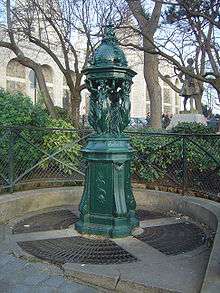 A Wallace fountain located in the Montmartre district of Paris | |
| Designer | Charles-Auguste Lebourg |
|---|---|
| Material | Cast iron |
| Beginning date | 1872 |
| Dedicated to | Richard Wallace |
Wallace fountains are public drinking fountains designed by Charles-Auguste Lebourg that appear in the form of small cast-iron sculptures scattered throughout the city of Paris, France, mainly along the most-frequented sidewalks. They are named after the Englishman Richard Wallace, who financed their construction. A great aesthetic success, they are recognized worldwide as one of the symbols of Paris. A Wallace Fountain can be seen outside the Wallace Collection in London, the gallery that houses the works of art collected by Sir Richard Wallace and the first four Marquesses of Hertford.
Background
During the Franco-Prussian War, Paris went through difficult times. The city was quickly rebuilt, despite the ravages it had suffered. In less than ten years, it was transformed, with new buildings (the Paris Opera, for example) and new boulevards (the Raspail and the St-Germain). Additionally, philanthropy was in fashion among the wealthy bourgeoisie, who financed numerous "good works" (such as the Red Cross and the Salvation Army) in order to uphold their image.
Sir Richard Wallace
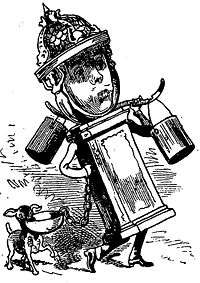
Among these philanthropists, Sir Richard Wallace (1818–1890) was one of the most eclectic and reserved. Having inherited a large fortune from his father in August 1870, he decided that all Parisians should profit from it, which made him popular. Wallace's devotion led him to remain in his Parisian villa even as the city was besieged, rather than take refuge on one of his palatial estates, to be in Paris when he was needed.
He founded a hospital, where he personally welcomed victims of the bombings and distributed supplies, among his other efforts on behalf of Parisians at war. He remained faithful to his adopted nation, France, and is buried at Père Lachaise Cemetery.
Of his numerous contributions to Parisian heritage, the best known today are the fountains which bear his name.
Why fountains?
As a result of the siege of Paris and the Commune episode, many aqueducts had been destroyed, and the price of water, already higher than normal, went up considerably. Because of this, most of the poor had to pay for water. Moreover most of the water carted about by vendors was drawn from the Seine river and was thus highly likely to be dirty; all the waste water from the streets and many of the sewers draining directly into it. It was therefore safer to drink beer or other alcoholic beverages and almost as cheap as water. The temptation to take to liquor was strong among the lower classes, and it was considered a moral duty to keep them from falling into alcoholism. Even today, when water and hygiene are not a problem for the majority of Parisians, these fountains are often the only sources of free water for the homeless.
The poor are not the only beneficiaries of these installations. Even if the aim of the fountains was to allow people of modest means to have access to drinking water, they are not the only ones who use them. Anyone passing by, rich or poor, may quench his thirst, fulfilling this vital need in equal fashion. There was already a programme of constructing temperance fountains in both the United States and in the United Kingdom.
Not only did the fountains accomplish Wallace's philosophy of lending a hand to those in need, but they also served to beautify Paris.
Conception
Richard Wallace designed the fountains himself and intended them to be beautiful as well as useful. The fountains had to meet several strict guidelines:
- Height: They had to be tall enough to be seen from afar but not so tall as to destroy the harmony of the surrounding landscape.
- Form: Both practical to use and pleasing to the eye.
- Price: Affordable enough to allow the installation of dozens.
- Materials: Resistant to the elements, easy to shape, and simple to maintain.
The locations, as well as the color (a dark green, like all urban development of that era, in order to blend in with the parks and tree-lined avenues), were quickly decided upon by the city government.
Wallace created two different models, which were followed by two additional models, so, in all, there were four types of Wallace fountains varying in such properties as height and motif. The material that was used to create them was cast-iron. Inexpensive, easy to mold, and robust, it was one of the most popular materials of the age. The majority of the cost was paid for by Wallace. The city of Paris allocated 1,000 francs for the large model and 450 francs for the wall-mounted model.
Sculptor
Wishing that his project be completed as rapidly as possible, Wallace called on Charles-Auguste Lebourg, a sculptor from Nantes whom he knew and whose talents were already renowned. Lebourg improved Wallace's sketches, already studied and thought-provoking, to make the fountains true works of art.
For the large model, Lebourg created four caryatids representing kindness, simplicity, charity and sobriety. Each one is different from her sisters, by the way she bends her knees and by where her tunic is tucked into her blouse.




Different models
The first two models (large model and applied model) were conceived and financed by Sir Richard Wallace, from whom they get their name. The two other models were created following the success of their predecessors inspired by the same styles and the resemblance is obvious. However, the more recent designs are not as strongly steeped in Wallace's aesthetic ideals, that in true Renaissance style, they should be useful, beautiful, and symbolic, in addition to being real works of art.
Large model
(size: 2.71 m, 610 kg)
The large model was conceived by Sir Richard Wallace, and was inspired by the Fontaine des Innocents. On a foundation of Hauteville stone rests an octagonal pedestal on which four caryatids are affixed with their backs turned and their arms supporting a pointed dome decorated by dolphins.
The water is distributed in a slender trickle issuing from the center of the dome and falls down into a basin that is protected by a grille. To make distribution easier, two tin-plated, iron cups attached to the fountain by a small chain were at the drinker's desire, staying always submerged for more cleanliness. These cups were removed in 1952 "for Hygiene reasons" by demand of the Council of Public Hygiene of the old Department of the Seine.
For more information, see the Technical File (in French).
Wall-mounted model
(size: 1.96 m, 300 kg)
Sir Richard's other model.[1] In the middle of a semi-circular pediment, the head of a naiad issues a trickle of water that falls into a basin resting between two pilasters. Two goblets allowed the water to be drunk, but they were retired under edict of the 1952 law cited above. This model, costing little to install, was to have been many units along the lengths of the walls of buildings with strong humanitarian focus, e.g. hospitals. This was unfortunately not the case and they do not remain today except for one situated on rue Geoffroy Saint-Hilaire.
Small model
(size: 1.32 m, 130 kg)
These are simple pushbutton fountains that one can find in squares and public gardens and are marked with the Parisian Seal (although the one installed on the Place des Invalides doesn't have this seal). They are very familiar to mothers who bring their children to play in the many small parks in Paris.
Measuring only 4'-3" and weighing 286 lbs., they were commissioned by the mayor of Paris more frequently than its older sister models.
Colonnade model
(size: 2.50 m, a little more than 500 kg)
This model was the last to be realized. The general shape resembles that of the Large Model and the caryatids were replaced with small columns to reduce the cost of fabrication. The dome was also less pointy and the lower part more curved.
Although thirty of these were made, today there remain only two, one on rue de Rémusat and the other on avenue des Ternes.

at Avenue d'Ivry

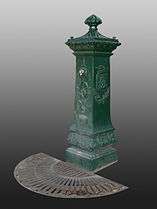

Placement
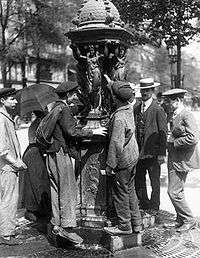
The choice of the location of the fountains was left to the city of Paris. They needed to be placed at the will of the public in a practical manner and integrated in the most harmonious fashion with the environment. Most were placed in squares or at the intersections of two roads. This made Eugene Belgrand (a hydraulic engineer, Director of Water and Sewers of Paris; he worked with the prefect Georges Haussmann) responsible for the choice, and one can consider that they were made in a judicious manner.
Today
Most of the fountains still present in the city still work, and distribute, contrary to popular belief, perfectly potable water. They are the rare points of free water in the city to the great relief of the homeless for whom they are a life-source and the thirst of passers-by which the fountains often quench. Sir Richard Wallace has achieved his goal and probably fulfilled his hopes.
The fountains work from 15 March to 15 November (the risk of freezing during the months of winter would imperil the internal plumbing), are regularly maintained, and repainted every two years.
They are an integral part of the Parisian landscape, typical and picturesque, of the same importance as the Eiffel Tower or the street urchins of Montmartre, as their creators would have wished. In Amélie, the cinegraphic piece about the glory of Parisian folklore, Jean-Pierre Jeunet baptised a personality Madeleine Wallace (she cried like a madeleine, or like a Wallace fountain), although the English subtitled version renamed the character of Madeleine, to Madeleine Wells for cultural understanding.
For more than a century they have been in place, and these monuments have never had to suffer criticism. They were always respected. However, curiously, they are not classified as "historic monuments".
Locations
Paris

The 67 large model fountains
3rd arrondissement
- Boulevard de Sébastopol, square Chautemps
- Passage du Pont aux biches
- Rue de la corderie, place Nathalie Lemel
4th arrondissement
- Place Louis Lépine, next to the Chambre de Commerce
- Place Louis Lépine, next to the Hôtel-dieu
- 7, Boulevard du Palais
- 123, rue Saint-Antoine
5th arrondissement
- Rue Poliveau, face rue de l'Essai
- Place Maubert
- 37, rue de la Bûcherie
- Place des Patriarches
6th arrondissement
- Place Saint-Germain-des-Prés
- Place Saint-Sulpice
- Pont Neuf, Quai des Grands Augustins
- Rue Vavin, at rue Bréa
- Place Saint-André-des-Arts

8th arrondissement
- Rue de St-Pétersbourg, at rue de Turin
- Av. des Champs-Élysées, Chevaux de Marly (north side)
- Av. des Champs-Élysées, Chevaux de Marly (south side)
9th arrondissement
- Place Gustave Toudouze
- Place de Budapest
10th arrondissement
- Place Juliette Dodu
- Place Jacques Bonsergent
- Place Robert Desnos
11th arrondissement
- 143, rue de la Roquette
- 197, Boulevard Voltaire
- 44, rue Jean-Pierre Timbaud
- 94, rue Jean-Pierre Timbaud
- 1, Boulevard Richard Lenoir
- 89, Boulevard Richard Lenoir
12th arrondissement
- Cours de Vincennes, face Blvd de Picpus
- Angle de St-Mandé, at rue du Rendez-vous
- Rue Descot, face Mairie du XIIe arrondissement
13th arrondissement
- 82, avenue d'Italie
- Rue de la Butte-aux-cailles, at rue de l'Espérance
- ZAC Baudricourt, at avenue d'Ivry
14th arrondissement
- Avenue Reille, at avenue René Coty
- Place Jules Hénaffe
- Place Edgard quinet, at rue de la Gaîté
- Place Denfert-Rochereau, at Blvd Raspail
- Avenue du Maine, face Mairie du XIVè arrondissement
15th arrondissement
- Place Henri Rollet
- 2, boulevard Pasteur
- Place du Général Beuret
- Place Charles Vallin
16th arrondissement
- 10, boulevard Delessert
- 194, avenue de Versailles
- Place Jean Lorrain
- Place de Passy
- Place du Père Marcellin Campagnat
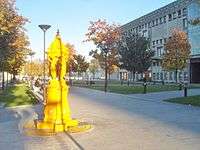
17th arrondissement
- 112, avenue de Villiers
- Place Aimé Maillard
- 15, avenue Niel
- 1, avenue de Wagram
- 112, boulevard des Batignolles
- Place de Lévis
18th arrondissement
- Place Emile Goudeau
- 42, boulevard Rochechouart
- Rue Saint-Eleuthère, at rue Azaïs
- Place des Abbesses
- Rue de la Goutte d'or, at rue de Chartres
19th arrondissement
- 214, boulevard de la Villette
- 139, Rue Meaux at Rue du Rhin
20th arrondissement
- Place Édith Piaf
- 6, rue Eugène Belgrand
- 29, boulevard de Ménilmontant
- Place Maurice Chevalier
- Rue Piat, face au square
The 11 small model fountains

4th arrondissement
- Place Louis Lepine
- Quai de la Corse
7th arrondissement
- Place des Invalides
11th arrondissement
- 32, boulevard Richard Lenoir
- 74, boulevard Richard Lenoir
13th arrondissement
- Place Paul Verlaine
15th arrondissement
- Place Alain Chartier
- Place Saint Charles
- 19, Place du Commerce
- 35, boulevard Pasteur
17th arrondissement
- 5, Place de Lévis
The 2 colonnaded fountains
16th arrondissement
- Rue de Rémusat, at Rue de Mirabeau
17th arrondissement
- Avenue des Ternes, at Place Pierre Demours
The wall-mounted model
5th arrondissement
- Intersection of fr:Rue Geoffroy Saint-Hilaire and fr:Rue Cuvier
Outside Paris
Nantes
The sculptor who created the fountains, Charles Auguste Lebourg, was originally from Nantes. In addition to the Parisian fountains, a few were placed in Nantes in honor of their creator:
- Place de la Bourse
- Parc de la Gaudinière
- Jardin des plantes, near the botanical garden
- Jardin des Plantes, Boulevard Stalingrad, bas du jardin, near the entrance to "Gare SNCF"
- Cours Cambronne

Bordeaux
On 6 October 1873, another philanthropist, Daniel Osiris, ordered six Large Model Fountains and asked the community of Bordeaux to install them. Three surviving fountains are to be found at:
- Place du Général Sarrail
- Jardin Public
- Gardens of the Hôtel de Ville
More recent fountains are to be found at:
- Place Mitchell (Mitchell was an Irishman who founded the city's first glassworks in rue de la Verrerie, creating the wine bottles that enabled the city to launch its international wine export trade)
- Cours Xavier Arnozan (ex. Pavé des Chartrons)
- Place Jacques Le Moine
- Place Stalingrad
- Place Porto-Riche
Agen
- On rue Grenouilla at Boulevard de la République
Clermont-Ferrand
- Between rue du 11 novembre and la Place de Jaude
Puteaux
- On Boulevard Richard Wallace
Saint-Denis, Réunion
- Inside Jardin de l'État.
Toulon
- At the municipal halls of the City
Pau
- Corner boulevard de la Paix and avenue de Buros
Private ownership
Some wealthy people with artistic interests, as well as celebrity artists, bought them for their pleasure. This was the case with Maurice Chevalier, who had them in his ownership in Marnes-la-Coquette, and Brigitte Bardot.
Outside France
Including Barcelona, Germany, Portugal, Italy, England, Northern Ireland, Zürich, Rio de Janeiro, Canada (Quebec), New Orleans, Montevideo, Jordan, Israel, and Macau.
Africa
Mozambique
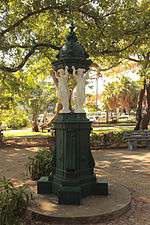
The fountain is in the Jardim Tunduru Botanical Gardens in Maputo.
Europe
Spain
- On the La Rambla avenue, next to the wax museum. It's one of the 2 remaining of the 12 fountains donated to Barcelona for the 1888 World Fair (The second one is at the intersection of Gran Via de les Corts Catalanes with Passeig de Gràcia). One of the 4 caryatids is affectionately nicknamed Vera.
- A third wallace fountain is located at the intersection of Gran Via de les Corts Catalanes with Marina street.
- On the Reina Sofia park. Donated by Juan Romero Rodriguez to the city of Ferrol after he purchased it for 1000 reales at the Exposition Universelle of 1889 in Paris.[2][3]
Italy
- The fountain is on the southern corner of Piazza Italia.
Northern Ireland
- Castle Gardens.
- Market Square, now relocated to Wallace Park, Lisburn
Switzerland

- In Pestalozzi Park along the Bahnhofstrasse.
- Promenade des Bastions (near The Reformation Wall).
Americas
Brazil
- Praça Dom Romualdo.
- Parque da Cidade.
- Alto da Boa Vista.
- Jardim Botânico
- Praça Dom João Esberard.
Quebec, Canada
- In Isabelle Park, on the corner of rue Dufferin and boulevard Leclerc. Installed in 1956, the fountain was a gift from France to celebrate Granby's "French Week".[4]
- Île Notre-Dame, Parc des Îles, Jardin de la France, Montreal. This fountain was offered to the City of Montréal by the city of Paris in 1980 during the 1980 International Floralies fair held in Montreal.
- One at the intersection of Grande-Allée and rue Cartier; another on rue Saint-Paul, by the turning to ruelle Légaré.
Louisiana, United States
- In Latrobe Park along Decatur Street, near the French Market.[5]
Uruguay
- On the corner of Yacare and Perez Castellano, outside the Mercado del Puerto.
- In the Plaza Matriz.
- In the Plaza Zabala.
- In the Plaza Cagancha.
- In front of the City Council, on the corner of 18 de Julio and Ejido.
- In the Plaza de los Treinta y Tres Orientales, right in front of the Firemen's Palace and next of the Dionisio Díaz statue.
Middle East
Jordan
- In Paris Circle, near the French Institute, in Jebel Al Weibdeh.[6]
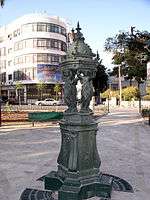
Israel
- In Paris Square
Asia
Macau SAR
The Wallace Fountain in Macau is known as 和麗女神噴泉 in Chinese and A Fonte Wallace in Portuguese.
- Inside Jardim de S. Francisco on Rua do Campo, set up in 2004
- Between Rua do Regedor and Rua Correia da Silva of Taipa Village, set up in 2005
See also
References
- ↑ The French term 'Modèle en applique' is similar to fr:Applique murale meaning wall lamp or sconce, as opposed to a free-standing model.
- ↑ http://www.lavozdegalicia.es/ferrol/2007/08/01/0003_6026718.htm
- ↑ http://oficialdecifra.blogspot.com/2014/04/fuente-wallace-del-parque-de-ferrol.html
- ↑ Tourisme Granby et Région
- ↑ Latrobe Park - French Quarter - New Orleans, LA foursquare.com
- ↑ ar:جبل اللويبدة
Further reading
- Marie-Hélène Levadé and Hugues Marcouyeau, Les fontaines de Paris : l'eau pour le plaisir. Paris, 2008 ISBN 978-2-915345-05-6 (French)
- Daniel Rabreau, Paris et ses fontaines. Paris, 1997 ISBN 978-2-905118-80-6 (French)
External links
| Wikimedia Commons has media related to Wallace fountains. |
- Mairie of Paris: the 108 Wallace fountains (French)
- GHM Sommevoire - manufacturer Wallace fountain (French)